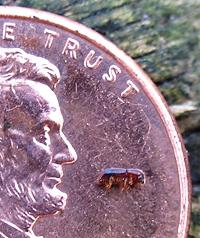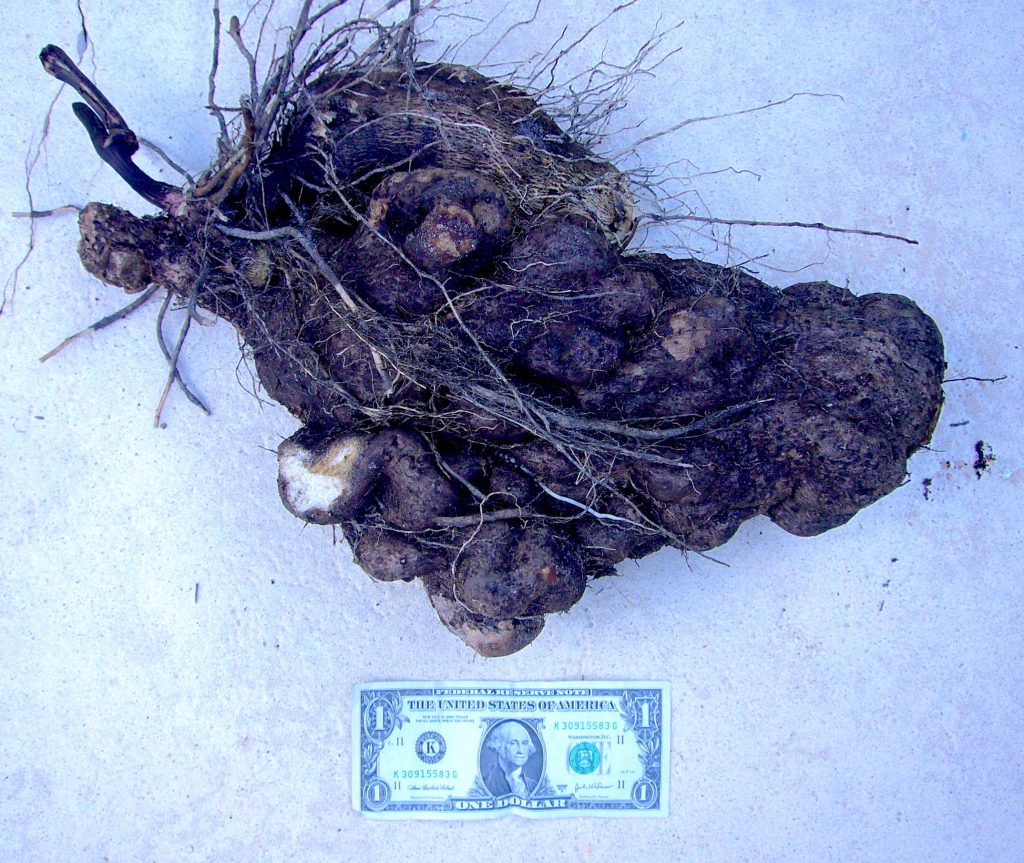
A small Winged Yam root (Dioscorea alata.) Photo by Green Deane
During our foraging class last Sunday in Gaineville we dug up a couple of Winged Yams, Dioscorea alata. It’s an easy time to identify the Winged Yam because its prolific relative– the invasive Air Potato — is fading for the season. While there are six species of “yams” locally the Winged Yam is the biggest caloric payoff. And it is a true yam not a variety of sweet potato (Ipomoea) which are improperly called “yams” and sold in cans and whole in grocery stores. Also called “Yam A” on my website — for Alata — we are interested in eating its root not its distinctive dark brown “air potatoes.” The plant’s root can grow to many pounds — 30 unattended, 150 cultivated — and is right below the surface usually. Boil it like a potato first then use it in like a potato. Its dark brown, misshapen “air potatoes” are quite visible this time of year hanging on the vine making it easy to find. You can read more about the Winged Yam and others here.
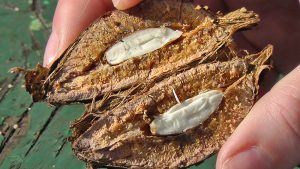
Tropical Almond kernel in a large almond-like shell.
Tropical Almonds are now on Mother Nature’s dining table and we hope to eat some this Sunday in our foraging class in West Palm Beach (Nov. 1st, remember the time change.) Terminalia catappa, which is really subtropical and not at all an almond, produces edible fruits for a few months. A tree I know was just starting to produce edible fruit the last time I was in Dreher Park. The ripe rind is edible as well as the “almond” inside which is really a little tree. It tastes like coconuts blended with almonds. The only problem is the buoyant dry shells are quite tough and require a hammer or a couple of rocks to crack open. (For those who don’t know Florida does not have rocks. You can’t just rummage around and find a pair of rocks to break seed shells with.) There is some labor involved with eating Tropical Alomonds but they are still calorie positive. I usually have a couple of pieces of concrete hidden near this particular tree to get to the treat. To read more about the Tropical Almond go here.

Classes are held rain or shine or cold. (Hurricanes are an exception.) Photo by Kelly Fagan.
I have one Foraging Class this weekend and it is Sunday in West Palm Beach. The weather should be favorable with all the heavy rain much farther north (if Hurricane Zeta cooperates.)
Sunday, November 1st, Dreher Park, 1200 Southern Blvd., West Palm Beach, 33405. We meet 300 feet north of the science museum near the banyan tees. 9 a.m. to noon.
Saturday, November 7th, Bayshore Live Oak Park, Bayshore Drive. Port Charlotte. 9 a.m. to noon. Meet at the parking lot at Bayshore and Ganyard.
Sunday, November 8th, Mead Garden: 1500 S. Denning Dr. Winter Park, FL 32789. Meet near the bathrooms. The entrance to the park is off Denning not Pennsylvania as some GPS say.
For more information, to pre-pay, or sign up go here.
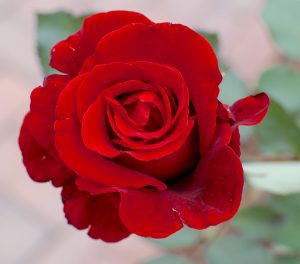
Roses are eaten carefully. Photo by Green Deane
While teaching this past weekend we noticed some roses getting ready to bloom. They can flower any time of year but locally prefer October to May. So start looking for roses. The blossoms are quite edible. In fact I have three gallons of Sparkling Rose Petal Wine aging for Valentine’s Day (though I haven’t had a “Valentine” for many years it pays to be an optimist.) Most folks already know that rose hips are high in vitamin C. They can vary in flavor from bitter to “sweet & sour.” Raw you eat only the outside portion of rose hips avoiding the seeds. The seeds have tiny hairs on them that are very irritating. They were the original itching powder and if consumed can cause what the Aboriginals called “itchy bottom disease.” You can cut the hips in half — if they are large — and let them dry then use the outside to make tea. Or you can use the entire rose hip for tea but pour it through a fine filter to take out the hairs. Another option is to boil the hip then squeeze the pulp through a screen or the like, capturing the seeds. Some people dry the hips and rub them in a sieve to get the hairs off leaving the seeds. It takes patience. To read more about roses go here.
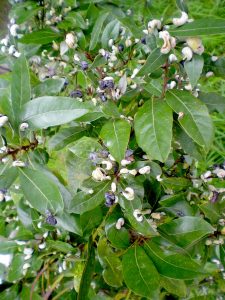
Persea borbonia (the Red Bay) often has many leaf galls.
How do you know if the leaf you are examining belongs to a Persia palustris (Swamp Bay) or Persia borbonia (Red Bay.) From a use point of view you can employ either for flavoring. The leaves of both are lance-shaped with gray-yellow stem and veins. Location is one hint. The Swamp Bay likes to be close to or in wet spots. The Red Bay likes higher and drier. The Red Bay also has more leaf galls than the Swamp Bay and is also being affected by the Laurel Wilt (see below.) If you happen to have a ten-powered magnifying glass you can look at the leaf stem. The Swamp Bay has stem hair that stands up. The Red Bay has stem hair that looks combed down. A third tree used for flavoring is the Sweet Bay, Magnolia virginiana. It has larger leaves than the other two but more importantly the back side of the leaf is white (that rubs off.) Of the three the Sweet Bay — which likes damp spots, too — is considered the most flavorful. You can read more about the “bays” here.
Mentioned above the Laurel Wilt, Raffaelea lauricola, was introduced in 2002 by the Ambrosia Beetle, Xyleborus glabratus. The wilt is moving out from ground zero which was Savannah, Georgia. As one might expect Laurel Wilt is killing trees in the Laurel family including Red Bays, Swamp Bays, Sassafras, and Camphors but not the Laurel Cherry which is in a different family. The wilt’s other target is avocados and has killed approximately 120,000 commercial avocado trees as well as many appreciated backyard specimens. Avocados were a $30 million business in the state in 2011 but has dropped to $12 million. The infestation has destroyed 36% of the susceptible trees in Florida, 42% in South Carolina and 66% in Gerogia. This also has impact on birds and animals dependent on those species. Lastly, what is a common vector for the beetle, that is, how does it get spread around? The insect can travel a few miles but another the vector is people taking infected firewood from home to burn on recreational trips.
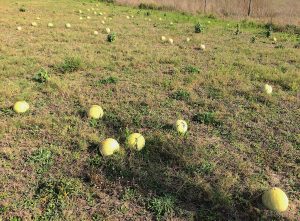
It’s easy to see where citrus used to grow. Look for the melons.
From the Mail Bag: “Couldn’t find any info about the Dudaim Melon on your website. It is a small little melon considered an invasive weed. It is growing in South Alabama and Florida too.” Thanks for writing, Rob. Botanically your melon is Cucumis melo var. dudaim. Its use is not unlike Citron Melon. Small fruits are sometimes used as preserves, or the rind is made into marmalade or pickles. There are many such small melons with varying edibility. Some are edible like larger melon except they are small. Some were intentionally planted to make marmalade or the like. A few are bitter and used as famine food only (which means you only eat it when you are starving.) Locally Citron Melons were here before citrus though it is in old or working citrus groves where one usually finds them. The Dudaim Melon was not cultivated for its edibility but for it fragrance. Incidentally, it has escaped cultivation and is a pest in many areas. It is naturalized in most of North America except for the high plains states and providences. As grass and the like die back with the shorter days you can see the melons in fields.
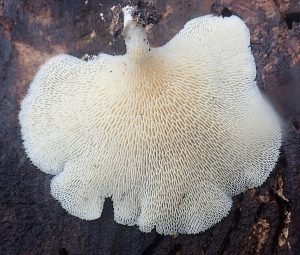
The Honeycombs name-changing Neofavolus brasiliensis. Photo by Green Deane
While Ringless Honey Mushrooms are in the limelight now other “honey” mushrooms can still be found. One that looks like an Oyster Mushroom from a distance but has a honeycomb arrangement instead of gills is Neofavolus brasilennsis (which might be its third name change in nearly as many years.) Technically a polypore with a white spore print, they’re very tough and don’t like to let go of a log. The species must be cooked and some think they are analogous to Shiitake mushrooms (which is a gastronomical stretch for a fungus many consider inedible.) It’s consumed more in Central American countries than elsewhere. The species has been recommended to be grown commercially — don’t hold your breath — and there may be some medicinal applications as well. They are a fun white fungi to spy and study once you realize you have not found an Oyster Mushroom. We should be seeing more of the later as we transition into cooler months.

Green Deane videos are now available on a USB.
Changing foraging videos: My nine-DVD set of 135 videos has been selling for seven years and are still available. They are the same videos I have on You Tube. Some people like to have a separate copy. A second option is a16-gig USB that has those 135 videos plus 15 more. While the videos can be run from the DVDs the videos on the USB have to be copied to your computer to play. They are MP4 files. The150-video USB is $99 and the 135-video DVD set is now $99. The DVDs will be sold until they run out then will be exclusively replaced by the USB. This is a change I’ve been trying to make for several years. So if you have been wanting the 135-video DVD set order it now as the price is reduced and the supply limited. Or you can order the USB. My headache is getting my WordPress Order page changed to reflect these changes. We’ve been working on it for several weeks. However, if you want to order now either the USB or the DVD set make a $99 “donation” using the link at the bottom of this page or here. That order form provides me with your address, the amount — $99 — tells me it is not a donation and in the note say if you want the DVD set or the USB.

Green Deane Forum
Want to identify a plant? Perhaps you’re looking for a foraging reference? You might have a UFO, an Unidentified Flowering Object, you want identified. On the Green Deane Forum we — including Green Deane and others from around the world — chat about foraging all year. And it’s not just about warm-weather plants or just North American flora. Many nations share common weeds so there’s a lot to talk. There’s also more than weeds. The reference section has information for foraging around the world. There are also articles on food preservation, and forgotten skills from making bows to fermenting food.
This is weekly newsletter #429, If you want to subscribe to this free newsletter you can find the sign-up form in the menu at the top of the page.
To donate to the Green Deane Newsletter click here.

